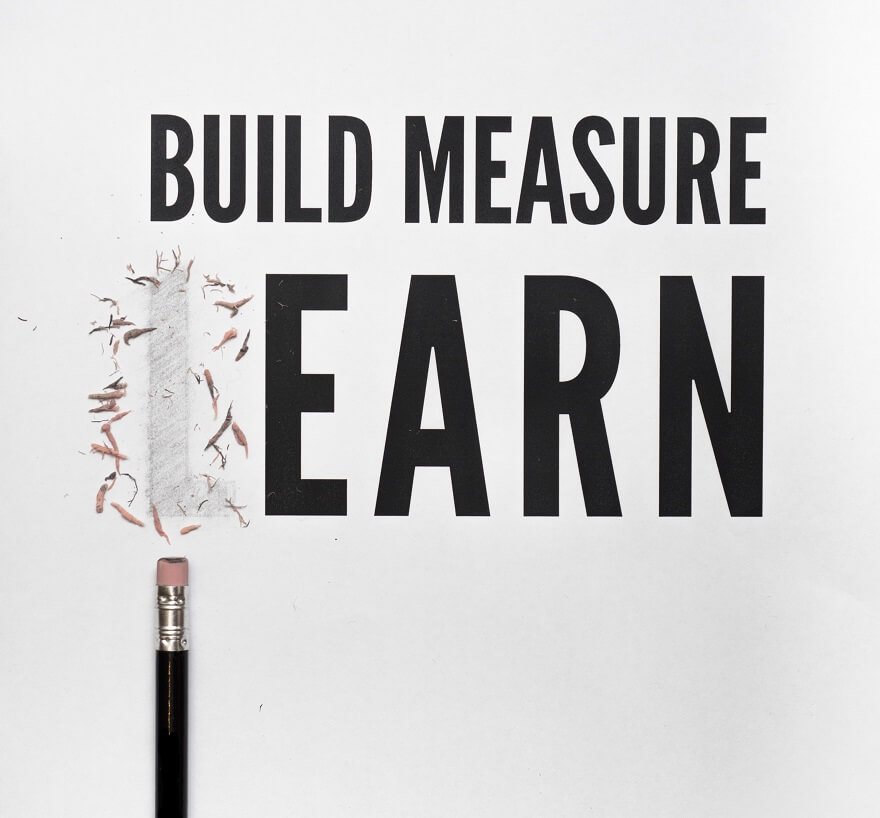
01 Jan How to address customer needs during product development
Build – Measure – Learn

One way to address customer needs while developing a product is to use the Lean Startup methodology: Build, Measure, Learn.
By using this method you are able to eliminate uncertainty during the product development process and make sure that you get constant customer feedback. The model Build, Measure, Learn is a cycle of creating and testing hypotheses by building something small for potential customers to try, measuring their reactions, and learning from the results. Don’t build your product or service blindly. Take the time to talk to your customers on a regular basis.
Your aspiration should be to continuously improve your product or service so that you deliver precisely what your customers want.

One way to address customer needs while developing a product is to use the Lean Startup methodology: Build, Measure, Learn.
By using this method you are able to eliminate uncertainty during the product development process and make sure that you get constant customer feedback. The model Build, Measure, Learn is a cycle of creating and testing hypotheses by building something small for potential customers to try, measuring their reactions, and learning from the results. Don’t build your product or service blindly. Take the time to talk to your customers on a regular basis.
Your aspiration should be to continuously improve your product or service so that you deliver precisely what your customers want.
The first step: P L A N

Even though the model is called “Build, Measure, Learn”, you shouldn’t start without a planning phase.
Your first task is to define the idea that you want to test and the information that you need to learn. You do this by developing a hypothesis an educated guess that requires experimentation and data to validate or invalidate.
Keep in mind that you should test to “improve” rather than to “prove”. Try to realize your experiment as fast and cheap as possible to avoid that sunk cost effects and confirmation biases influence your decision.
The first step: P L A N
Even though the model is called “Build, Measure, Learn”, you shouldn’t start without a planning phase.
Your first task is to define the idea that you want to test and the information that you need to learn. You do this by developing a hypothesis an educated guess that requires experimentation and data to validate or invalidate.
Keep in mind that you should test to “improve” rather than to “prove”. Try to realize your experiment as fast and cheap as possible to avoid that sunk cost effects and confirmation biases influence your decision.

The second step: B U I L D

To validate your hypothesis you build a Minimum Viable Product in short MVP, a minimal effort product with the maximal potential to validate the assumptions behind the value proposition. Whatever MVP you choose, it needs to show just enough core features to attract the interest of early adopters the people who’ll likely want to buy your product as soon as it launches.
Take care not to overinvest in your MVP. If you can you should use human interaction or off-the-shelf technology to fake a functional product or service. Try to think outside the box, often is a simple landing page or a video simulation good enough.

The second step: B U I L D
To validate your hypothesis you build a Minimum Viable Product in short MVP, a minimal effort product with the maximal potential to validate the assumptions behind the value proposition. Whatever MVP you choose, it needs to show just enough core features to attract the interest of early adopters the people who’ll likely want to buy your product as soon as it launches.
Take care not to overinvest in your MVP. If you can you should use human interaction or off-the-shelf technology to fake a functional product or service. Try to think outside the box, often is a simple landing page or a video simulation good enough.
The third step: M E A S U R E

Now you measure the results that you obtained in the building phase. Was your hypothesis valid or invalid? Is there sufficient interest in your idea to continue developing it? Does the data show that you’ll be able to build a sustainable business around your product or service? Will your markets and end customers make use of the future product or service?
Measurement can be daunting, especially if the organization is used to running on emotion and gut feel of the executive team. That’s why your measurement should focus on quantitative data based on actual user behavior.
The third step: M E A S U R E
Now you measure the results that you obtained in the building phase. Was your hypothesis valid or invalid? Is there sufficient interest in your idea to continue developing it? Does the data show that you’ll be able to build a sustainable business around your product or service? Will your markets and end customers make use of the future product or service?
Measurement can be daunting, especially if the organization is used to running on emotion and gut feel of the executive team. That’s why your measurement should focus on quantitative data based on actual user behavior.

The fourth step: L E A R N

By the time you reach the learning stage, you’ll be equipped to make a profound, evidence-based business decision about what to do next. There are then two ways forward:
One option is to proceed: Your product idea was a success, so you decide to take it to the next level. You repeat the feedback loop to continuously improve and refine your product or service.
The second option is to Pivot: The experiment has refuted your hypothesis, so your assumptions have been wrong. You can reset, or correct your course and repeat the loop, using what you’ve learned.

The fourth step: L E A R N
By the time you reach the learning stage, you’ll be equipped to make a profound, evidence-based business decision about what to do next. There are then two ways forward:
One option is to proceed: Your product idea was a success, so you decide to take it to the next level. You repeat the feedback loop to continuously improve and refine your product or service.
The second option is to Pivot: The experiment has refuted your hypothesis, so your assumptions have been wrong. You can reset, or correct your course and repeat the loop, using what you’ve learned.
Written by Tobias Beau
– sharing is caring –
